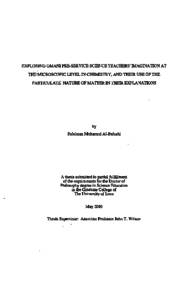Document
Exploring Omani pre-service science teachers' imagination at the microscopic level in chemistry, and their use of the particulate nature of matter in their explanations.
Publisher
Sultan Qaboos University
Gregorian
2003
Language
English
Subject
English abstract
level of matter and their use of the Particulate Theory of Matter. As for the imagination component, twenty-two Omani pre-service science teachers were encouraged individually during a guided imagery session to construct images for the interactions among micro-species such as molecules, atoms, and electrons. The findings determined several factors that contributed in shaping participants' mental images at the microscopic level of mater. Some of these factors related to previous experience, mental abilities, and the nature of microscopic interactions. This study argued that participants lacked a homogeneous and reliable mental model of the atom that was required to carry out advance cognitive processes for mental exploration of chemical phenomena. In addition, the imagination of three female participants was further analyzed to explore their information processing of the microscopic imagined actions. They were chosen because they created different atomic models from each other. These models were: space-filling balls model, humanized model, and Latin characters model. Each participant's created mental images of microscopic actions were discussed based on her atomic model: The findings suggested that the nature of each participant's model partially influenced her microscopic imagined actions.
The second component of this study tested the effect of different textual, pictorial, and reflective clues on participants' use of the microscopic level, the accuracy of their explanations and the originality of their inventions. The clues, either microscopic or macroscopic were administered in a researcher-designed test to 152 Omani pre-service science teachers. The findings revealed that students did not use the PTM theory unless they were cued. The particulate level of the explanations of those who received a microscopic guided imagery textual clue was significantly higher than those who received a macroscopic clue. Also, the accuracy of explanations of participants who 2CIO received a microscopic pictorial clue was significantly higher than those who received the macroscopic picture. In addition, a microscopic reflective clue improved the microscopic level of 43 participants' explanations. However, the microscopic textual clue did not have a significant effect on the accuracy of explanations, or on the originality of inventions.
Member of
Resource URL
Category
Theses and Dissertations

